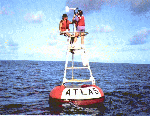

Front Cover: Recovering an ATLAS mooring from the French R/V LE NOROIT in the western equatorial Pacific Ocean. A total of 59 ATLAS moorings are deployed at present in the equatorial Pacific as part of the TOGA-TAO Array. Maintenance of this array requires nearly 1 year of dedicated shiptime. The array is supported by the United States, France, Japan, Korea, and Taiwan. Photography by A.J. Shepherd of NOAA/Pacific Marine Environmental Laboratory
Back Cover: Servicing an ATLAS mooring of the TOGA-TAO Array. ATLAS moorings measure surface winds, air temperature, relative humidity, sea surface temperature, and subsurface temperature to depths of 500 m. All data are telemetered to shore in real-time via Service Argos. Photography by J. Neander of NOAA/Pacific Marine Environmental Laboratory and J. Stahl of the University of Hawaii.
Fig. 1: The TOGA-TAO Array in August 1993 and in its final configuration December 1994. ATLAS moorings (diamond), and current-meter moorings (square).
Fig. 2: Time series of (A) surface winds and (B)
sea-surface temperature
at selected locations along the equator. Daily data have been
lightly smoothed with a 5-day
Hanning filter for clearer presentation. Island wind data from
Kapingamarangi (1°00N,
154°50
E)
and Naura (0°32
E,
166°54
E) have been
substituted where gaps exist in the mooring
time series. Dashed lines are long-term monthly averages based
on the Comprehensive Ocean Atmosphere Data
Set (COADS) for winds in (A) and on COADS-Ice analyses for
SST (Reynolds, 1988) in (B).
Fig. 3: (A) Monthly mean SST (in °C) averaged between 2°N and 2°S as a function of time and longitude based on TAO buoy data. Contour interval is 0.5°C. Symbols along the top abscissa indicate longitudes where data were available at the start of the record (August 1986); symbols along the bottom abscissa indicate longitudes where data were available at the end of the record (mid-August 1993). The actual distribution with time is shown in (B). Months with data at 2°S, 0°N, and 2°N are indicated by a square, triangle, and circle, respectively.
Fig. 4: Monthly mean anomalies averaged between 2°N and
2°S for (A) zonal winds (m s)
and (B) SST (°C) as a function of time and longitude.
Symbols along the top abscissa
indicate longitudes where data were available at the start of the
record (August 1986); symbols
along the bottom abscissa indicate longitudes where data were
available at the end of the record
(mid-August 1993). Contour intervals are 1 m s
in (A) and 0.5°C in
(B).
Fig. 5: Contour plots of zonal velocity (cm s) in the top 250 m from PROTEUS
moorings
on the equator at (A) 165°E, (B) 140°W
and (C) 110°W for
September 1991 to August 1992. Westward (negative) flow is
shaded blue; eastward (positive)
flow is shaded yellow to red. Data have been smoothed with an
11-d Hanning filter.
Fig. 6: Anomalies in the depth of the 20°C isotherm (in m) averaged between 2°N and 2°S for July 1991 to mid-August 1993. Anomalies are based on TAO buoy data smoothed to 5-day averages and differenced from an XBT climatology (Kessler, 1990). Contour interval is 10 m. Symbols along the top abscissa indicate longitudes where data were available at the start of the record; symbols along the bottom abscissa indicate longitudes where data were available at the end of the record.
Fig. 7: Monthly mean SST (°C) and monthly mean surface wind vectors from TAO buoy data for August 1991 and August 1992. SST data are gridded using an objective analysis procedure with the Reynolds (1988) averages as a first guess field.
Return to Publications and Abstracts page